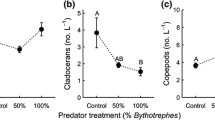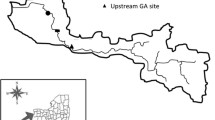Abstract
With ecosystems increasingly supporting multiple invasive species, interactions among invaders could magnify or ameliorate the undesired consequences for native communities and ecosystems. We evaluated the individual and combined effects of rusty crayfish (Orconectes rusticus) and Chinese mystery snails [Bellamya (=Cipangopaludina) chinensis] on native snail communities (Physa, Helisoma and Lymnaea sp.) and ecosystem attributes (algal chlorophyll a and nutrient concentrations). Both invaders are widespread in the USA and commonly co-occur within northern temperate lakes, underscoring the importance of understanding their singular and joint effects. An outdoor mesocosm experiment revealed that while the two invaders had only weakly negative effects upon one another, both negatively affected the abundance and biomass of native snails, and their combined presence drove one native species to extinction and reduced a second by >95%. Owing to its larger size and thicker shell, adult Bellamya were protected from crayfish attack relative to native species (especially Physa and Lymnaea), suggesting the co-occurrence of these invaders in nature could have elevated consequences for native communities. The per capita impacts of Orconectes (a snail predator) on native snails were substantially greater than those of Bellamya (a snail competitor). Crayfish predation also had a cascading effect by reducing native snail biomass, leading to increased periphyton growth. Bellamya, in contrast, reduced periphyton biomass, likely causing a reduction in growth by native lymnaeid snails. Bellamya also increased water column N:P ratio, possibly because of a low P excretion rate relative to native snail species. Together, these findings highlight the importance of understanding interactions among invasive species, which can have significant community- and ecosystem-level effects.





Similar content being viewed by others
References
Adams MJ, Pearl CA, Bury RB (2003) Indirect facilitation of an anuran invasion by non-native fishes. Ecol Lett 6:343–351
Bernot RJ (2003) Trematode infection alters the antipredator behavior of a pulmonate snail. J North Am Benthol Soc 22:241–248
Branson BA (1977) The Chinese apple snail, Cipangopaludina chinensis, on Orcas Island, Washington. Nautilus 91:76–77
Brown KM (1998) The role of shell strength in selective foraging by crayfish for gastropod prey. Freshwater Biol 40:255–260
Bruno JF, Fridley JD, Bromberg KD, Bertness MD (2005) Insights into biotic interactions from studies of species invasions. In: Sax DF, Stachowicz JJ, Gaines SD (eds) Species invasions: insights into ecology, evolution, and biogeography. Sinauer, Sunderland, pp 13–40
Bury JA, Sietman BE, Karns BN (2007) Distribution of the non-native viviparid snails, Bellamya chinensis and Viviparus georganius, in Minnesota and the first record of Bellamya japonica from Wisconsin. J Freshwater Ecol 22:697–703
Byers JE, Reichard SH, Randall JM, Parker IM, Smith CS, Lonsdale WM, Atkinson IAE, Seastedt TR, Williamson M, Chornesky E, Hayes D (2002) Directing research to reduce the impacts of nonindigenous species. Conserv Biol 16:630–640
Carlsson NOL, Brönmark C, Hansson LA (2004) Invading herbivory: the golden apple snail alters ecosystem functioning in Asian wetlands. Ecology 85:1575–1580
Clench WJ, Fuller SLH (1965) The genus Viviparus (Viviparidae) in North America. Occas Pap Mollusks 32:385–412
Cope NJ, Winterbourn MJ (2004) Competitive interactions between two successful molluscan invaders of freshwaters: an experimental study. Aquat Ecol 38:83–91
Crooks JA (2002) Characterizing ecosystem-level consequences of biological invasions: the role of ecosystem engineers. Oikos 97:153–166
Dillon RT (2000) The ecology of freshwater molluscs. Cambridge University Press, Cambridge
Dudgeon D, Arthington AH, Gessner MO, Kawabata ZI, Knowler DJ, Lévèque C, Naiman RJ, Prieur-Richard AH, DSoto ML, Stiassny J, Sullivan CA (2006) Freshwater biodiversity: importance, threats, status and conservation challenges. Biol Rev 81:163–182
Dundee DS (1974) Catalog of introduced molluscs of eastern North America. Sterkiana 55:1–37
Elton CS (1958) The ecology of invasions by animals and plants. Muehuen, London
Evans-White MA, Lamberti GA (2006) Stochiometry of consumer-driven nutrient recycling across nutrient regimes in streams. Ecol Lett 9:1186–1197
Fournier V, Rosenheim JA, Brodeur J, Diez JM, Johnson MW (2006) Multiple plant exploiters on a shared host: testing for nonadditive effects on plant performance. Ecol Appl 16:2382–2398
Grosholz ED (2005) Recent biological invasion may hasten invasional meltdown by accelerating historical introductions. Proc Natl Acad Sci USA 102:1088–1091
Grosholz ED, Ruiz GM, Dean CA, Shirley KA, Maron JL, Connors PG (2000) The impacts of a nonindigenous marine predator in a California bay. Ecology 81:1206–1224
Havel JE, Lee CE, Vander Zanden MJ (2005) Do reservoirs facilitate invasions into landscapes? Bioscience 55:518–525
Hayes MP, Jennings MR (1986) Decline of ranid frog species in western North America: are bullfrogs (Rana catesbeiana) responsible? J Herpetol 20:490–509
Hein CL, Roth BM, Ives AR, Vander Zanden MJ (2006) Fish predation and trapping for rusty crayfish (Orconectes rusticus) control: a whole-lake experiment. Can J Fish Aquat Sci 63:383–393
Johnson LE, Bossenbroek JM, Kraft CE (2006) Patterns and pathways in the post-establishment spread of non-indigenous aquatic species: the slowing invasion of North American inland lakes by the zebra mussel. Biol Invasions 8:475–489
Johnson PTJ, Olden JD, Vander Zanden MJ (2008) Dam invaders: impoundments facilitate biological invasions into freshwaters. Front Ecol Environ 6:357–363
Johnson PTJ, Chase JM, Dosch KL, Gross J, Hartson RB, Larson DJ, Sutherland DR, Carpenter SR (2007) Aquatic eutrophication promotes pathogenic infection in amphibians. Proc Natl Acad Sci USA 104:15781–15786
Jokinen EH (1982) Cipangopaludina chinensis (Gastropoda, Viviparidae) in North America; review and update. Nautilus 96:89–95
Kiesecker JM, Blaustein AR (1998) Effects of introduced bullfrogs and smallmouth bass on microhabitat use, growth and survival of native red-legged frogs (Rana aurora). Conserv Biol 12:776–787
Lewis DB, Magnuson JJ (2000) Landscape spatial patterns in freshwater snail assemblages across Northern Highland Catchments. Freshwater Biol 43:409–420
Lodge DM, Kershner MW, Aloi JE, Covich AP (1994) Effects of an omnivorous crayfish (Orconectes rusticus) on a freshwater littoral food web. Ecology 75:1265–1281
Mackie GL (1999) Introduction of molluscs through the import for live food, chapter 21. In: Claudi R, Leach J (eds) Non-indigenous freshwater organisms: vectors, biology and impacts. Lewis, Boca Raton
McCarthy JM, Hein CL, Olden JD, Vander Zanden MJ (2006) Coupling long-term studies with meta-analysis to investigate impacts of non-native crayfish on zoobenthic communities. Freshwater Biol 51:224–235
Mills EL, Leach JH, Carlton JT, Strayer DL (1993) Exotic species in the Great Lakes: a history of biotic crises and anthropogenic introductions. J Great Lakes Res 19:1–54
Nyström P, Svensson O, Lardner B, Bronmark C, Graneli W (2001) The influence of multiple introduced predators on a littoral pond community. Ecology 82:1023–1039
Nyström P, Bronmark C, Graneli W (1999) Influence of an exotic and a native crayfish species on a littoral benthic community. Oikos 85:545–553
Nyström P, Perez JR (1998) Crayfish predation on the common pond snail (Lymnaea stagnalis): the effect of habitat complexity and snail size on foraging efficiency. Hydrobiologia 368:201–208
O’Dowd DJ, Green PT, Lake PS (2003) Invasional meltdown on an oceanic island. Ecol Lett 6:812–817
Olden JD, McCarthy JM, Maxted JT, Fetzer WW, Vander Zanden MJ (2006) The rapid spread of rusty crayfish (Orconectes rusticus) with observations on native crayfish declines in Wisconsin (USA) over the past 130 years. Biol Invasions 8:1621–1628
Osenberg CW, Mittelbach GG (1989) The effects of body size on the predatory–prey interaction between pumpkinseed sunfish and gastropods. Ecol Monogr 59:405–432
Parker IM, Simberloff D, Lonsdale WM, Goodell K, Wonham W, Kareiva PM, Williamson MH, Von Holle B, Moyle PB, Byers JE, Goldwasser L (1999) Impact: towards a framework for understanding the ecological effects of invaders. Biol Invasions 1:3–19
Pimental D, Lach L, Zuniga R, Morrison D (2000) Environmental and economic costs of nonindigenous species in the United States. Bioscience 50:53–65
Puth LM, Post DM (2005) Studying invasion: have we missed the boat? Ecol Lett 8:715–721
Pyšek P, Richardson DM, Pergl J, Jarošik V, Sixtová Z, Weber E (2008) Geograghical and taxonomic biases in invasion ecology. Trends Ecol Evol 23:237–244
Rundle SD, Brönmark C (2001) Inter- and intraspecific trait compensation of defence mechanisms in freshwater snails. Proc R Soc Lond B 268:1463–1468
Quinn GP, Keough MJ (2002) Experimental design and data analysis for biologists. Cambridge University Press, Cambridge
Ricciardi A (2001) Facilitative interactions among aquatic invaders: is an “invasional meltdown” occurring in the Great Lakes? Can J Fish Aquat Sci 58:2513–2525
Ricciardi A (2003) Predicting the impacts of an introduced species from its invasion history: an empirical approach applied to zebra mussel invasions. Freshwater Biol 48:972–981
Ricciardi A, Rasmussen JB (1998) Predicting the identity and impact of future biological invaders: a priority for aquatic resource management. Can J Fish Aquat Sci 55:1759–1765
Ross DJ, Johnson CR, Hewitt CL, Ruiz GM (2004) Interaction and impacts of two introduced species on a soft-sediment marine assemblage in SE Tasmania. Mar Biol 144:747–756
Ruiz GM, Fofonoff PW, Carlton JT, Wonham MJ, Hines AH (2000) Invasion of coastal marine communities in North America: apparent patterns, processes and biases. Annu Rev Ecol Syst 31:481–531
Sih A, Englund G, Wooster D (1998) Emergent impacts of multiple predators on prey. Trends Ecol Evol 13:350–355
Smith DG (2000) Notes on the taxonomy of introduced Bellamya (Gastropoda: Viviparidae) species in northeastern North America. Nautilus 114:31–37
Stein RA, Goodman CG, Marschall EA (1984) Using time and energetic measures of cost in estimating prey value for fish predators. Ecology 65:702–715
Strayer DS (1987) Ecology and zoogeography of the freshwater mollusks of the Hudson River Basin. Malacol Rev 20:1–68
Strayer DS, Eviner VT, Jeschke JM, Pace ML (2006) Understanding the long-term effects of species invasions. Trends Ecol Evol 21:645–651
Stromberg JC, Lite SJ, Marler R, Paradzick C, Shafroth PB, Shorrock D, White JM, White MS (2007) Altered stream-flow regimes and invasive plant species: the Tamarix case. Glob Ecol Biogeogr 16:381–393
Teskey MC (1954) The mollusks of Brown County, Wisconsin. Nautilus 68:24–28
Turner AM, Chislock MF (2007) Dragonfly predators influence biomass and density of pond snails. Oecologia 153:407–415
Vitousek PM, Mooney HA, Lubchenco J, Melillo JM (1997) Human domination of earth’s ecosystems. Science 277:494–499
Vonesh JR, Osenberg CW (2003) Multi-predator effects across life-history stages: non-additivity of egg- and larval-stage predation in an African treefrog. Ecol Lett 6:503–508
Wootton JT (1994) Putting the pieces together: testing the independence of interactions among organisms. Ecology 75:1544–1551
Yan ND, Girard R, Boudreau S (2002) An introduced invertebrate predator (Bythotrephes) reduces zooplankton species richness. Ecol Lett 5:481–485
Acknowledgements
We acknowledge K. Langree, E. Vennie, N. Hayes, and Z. Shattuck for assistance collecting data. T. Kratz, E. Stanley, J. Thoyre, and M. Lochner provided logistical support. L. Winn facilitated access to land while the WDNR Forestry Fire division filled mesocosms with water. We thank L. Herman, R. Martin, T. Asplund, D. Olson, and J. Filbert for providing invader distributional data along with the following agencies: WDNR, MI Department of Environmental Quality, the North-Temperate Lakes Long-Term Ecological Research, and the Great Lakes Indian Fish and Wildlife Commission. R. Dillon identified snail species used in the experiment. For funding support, we thank the Juday Family Fellowship, the Anna Grant Birge Fund, and NSF awards DEB-0411760 and the North-Temperate Lakes Long-Term Ecological Research program (DEB-0217533). Experiments were in compliance with the current laws of the USA.
Author information
Authors and Affiliations
Corresponding author
Additional information
Communicated by Craig Osenberg.
Rights and permissions
About this article
Cite this article
Johnson, P.T.J., Olden, J.D., Solomon, C.T. et al. Interactions among invaders: community and ecosystem effects of multiple invasive species in an experimental aquatic system. Oecologia 159, 161–170 (2009). https://doi.org/10.1007/s00442-008-1176-x
Received:
Accepted:
Published:
Issue Date:
DOI: https://doi.org/10.1007/s00442-008-1176-x




